BestReviews is reader-supported and may earn an affiliate commission. Details
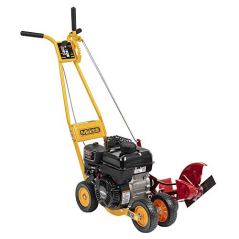
Although it offers notable performance and power, you can find similar qualities in less expensive options on our list.
Although it offers notable performance and power, you can find similar qualities in less expensive options on our list.
Has a powerful 5.50-torque engine, yet gets high marks for being easy to handle. Not extremely loud considering the power it delivers. Produces straight, clean-looking edges. Build has a very sturdy feel, and depth control is easy to adjust.
Mixed reviews on how reliable it is to start. Quality control could be better, as some packages arrived with damage. Pricey.
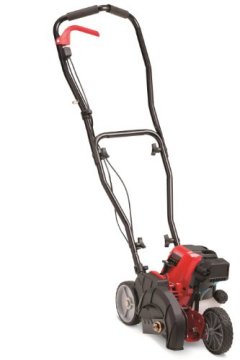
Despite being a bit underpowered, it's worth considering if you want an easy-to-use edger to give a neat look along sidewalks and landscaping.
Despite being a bit underpowered, it's worth considering if you want an easy-to-use edger to give a neat look along sidewalks and landscaping.
Features a compact build and straightforward operation that makes it easy for most users to operate. Weighs less than 30 pounds. Has a contoured handle. Height adjustment offers 6 positions for various edging jobs.
Not as powerful as other options on our list. Has some flimsy plastic pieces. Doesn't always start on the first try.
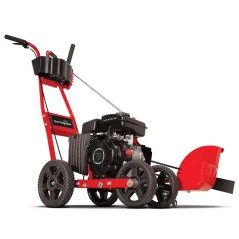
A great edger that is perfect for professional-grade jobs.
A great edger that is perfect for professional-grade jobs.
The oversized wheels allow for it to roll over most obstacles. Has a debris guard to protect users from harm. The overpowered engine allows the blades to cut through anything. Easy to cut straight lines.
Assembly can be rather tricky for some users.
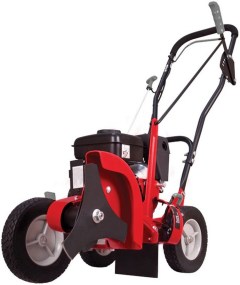
A walk-behind, 79cc OHV-engine model best suited for lighter work.
A walk-behind, 79cc OHV-engine model best suited for lighter work.
Manual recoil, easy-start system. Adjustable to 5 depths, up to 2.5 inches. Triangular 3-point blade. Blade angle adjusts +/- 15 degrees for bevel-edging capabilities. Metal frame and blade guard for increased durability. EPA- and CARB-certified.
Low engine power and non-adjustable stationary throttle speed.
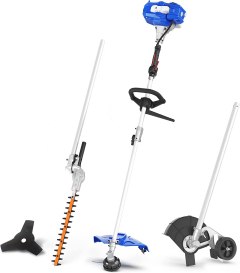
Landscape your yard with this 4-in-1 gas-powered grass edger with sharp, precise blades and an easy-to-control design.
Landscape your yard with this 4-in-1 gas-powered grass edger with sharp, precise blades and an easy-to-control design.
It's a string edger, wheeled edger, hedge trimmer, and brush cutter. The full crank 2-cycle engine gets remarkable power within 5 pulls. This is great for people who need the basics but don't want a lot of tools that take up space.
Quite heavy, and some buyers had a hard time assembling it.

We recommend these products based on an intensive research process that's designed to cut through the noise and find the top products in this space. Guided by experts, we spend hours looking into the factors that matter, to bring you these selections.
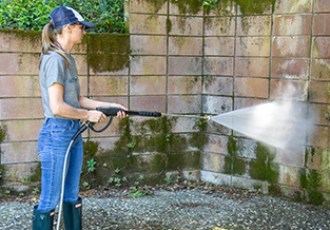
Plenty of thought and effort goes into crafting a meticulously gorgeous lawn, especially when it comes to creating boundaries. You may want to show off some parts, like your flower beds, and protect other parts from encroaching weeds, like your sidewalks and pathways. When significant power is required to dig into soil and penetrate dense, rough patches of lawn, you need a gas-powered lawn edger.
Edgers create boundaries of various widths and depths. You may be interested in an edger for maintenance purposes, aesthetic purposes, or both. Gas lawn edgers are the most powerful edgers available. If you have a big edging project to tackle, a gas-fed edger is an apt choice, especially if you want to get the job done quickly and with precision.
Whether you’re a homeowner or a professional landscaper, this buying guide can help you choose a gas lawn edger. Read on to learn what to expect when using a gas edger, how they compare to other types of edgers and how to go about buying the right one.

Gas is often the preferred power source for large, intense edging tasks. Gas tools offer more potency than electric tools, and they definitely exert more power than manual tools. A gas lawn edger easily digs deep into soil, especially in areas that haven’t previously been dug up. They are similar in size to, or even larger than, electric edgers. It’s pretty easy to find a gas edger sized for the project you want to tackle.
Gas lawn edgers are also known for precision. While electric and manual edgers tend to be handheld, gas lawn edgers are wheeled machines that create uniform depth throughout the job.
If you own other gas-powered items, such as a gas lawn mower or gas hedge trimmer, incorporating a gas edger into your collection should be fairly simple, as they require similar maintenance and safety precautions.
Gas-powered lawn edgers are heavier and pricier than their electric counterparts. Gas lawn tools in general, and lawn edgers in particular, can contribute to noise and air pollution. Some require the use of earplugs. As they can be large and bulky, you will need a suitable place to store the machinery. Also, bear in mind that you’ll need to regularly gas up the machine.
Gas-powered lawn edgers, which feature one or more wheels, are appropriate for medium to large lawns that require regular maintenance. They’re useful if you have gardens, flower beds, pathways, trees, and other areas you want to define. To achieve a precise cut, wheel the gas edger slowly forward. The pace should be much slower than you’d move a lawn mower.
Gas-powered lawn edgers come with two-cycle or four-cycle motors. If you use a two-cycle machine, you must mix the oil and gas in proper proportions. If you use a four-cycle machine, the gas and oil mix automatically. The latter are more powerful and energy efficient. They also tend to be larger, louder, and pricier.
Engine power for a gas lawn edger is measured in cubic centimeters (cc) or torque. These machines range from 20 cc all the way up to 150 cc, or from 5 to 7 foot-pounds of torque. The higher the numbers, the more powerful the machine. Higher numbers also indicate a higher weight and price.
Consider the size of the blade and how deep it can cut into the earth. You may want several depth options to cater to different areas of your lawn. For edging around driveways and sidewalks, a 2-inch depth would probably suffice. You may want a more pronounced boundary in other areas. Note that if you’re burying cables in your lawn, you’ll need much greater depth.
Gas lawn edgers are heavy, with some weighing 60 to 70 pounds. While the wheels tend to be durable and the units relatively easy to push, consider the slope and terrain of your yard before buying. It’s more difficult to push a heavy edger up a slope.




















An edger with an adjustable blade angle can create more intricate cuts. Some blades tilt slightly to create a beveled edge. The degree to which the blade can slant varies from model to model. Some turn up to 90 degrees and perform trimmer functions as well.
While changing the height of the blade helps with depth, you may want to go over or around certain obstacles on your lawn. Some edgers allow you to adjust wheel height for further customization. This is particularly useful if you’re edging a curb.
Weed eater: Husqvarna Gas String Trimmer
Maintain the boundaries you created with your edger by using a weed eater. This gas-powered string trimmer by Husqvarna is powerful and can handle the toughest of tasks.
Hedge trimmer: BLACK + DECKER 40V Cordless Hedge Trimmer
Another part of your lawn that shouldn’t be overlooked is the bushes. This electric hedge trimmer from BLACK+DECKER is lightweight, inexpensive, and easy to store.
Lawn mower: Greenworks 12-Amp Electric Corded Lawn Mower
The central task of maintaining an immaculate lawn is cutting the grass. We recommended investing in this Greenworks corded lawn mower that can bag or mulch clippings.
Inexpensive: The bigger and more powerful the edger, the pricier it will be. At a minimum, you can expect to pay around $150 for a gas-powered lawn edger.
Mid-range: Gas lawn edgers that are more potent can cost up to $300. These tend to be four-cycle machines with adjustable features.
Expensive: The most durable and powerful gas lawn edgers cost around $500. These machines are useful for contractors and others who use them regularly.

Q. How should I maintain my gas lawn edger?
A. Regularly remove soil and grass from the edger after use. (To do this, wear a pair of work gloves, and make sure the machine is properly turned off first.) Removing the debris prevents it from hardening around the blade.
Your blade may need to be regularly sharpened, depending on how often you use the edger. The average user can expect to sharpen the blade several times a year. This can be done at home or in a shop.
Q. How should I store my gas lawn edger in the off-season?
A. Before storing your gas lawn edger for a long period of time, make sure the tank is empty of gas. You may want to incorporate a fuel stabilizer so the machine doesn’t clog with leftover gas. Siphon out the gas, or run the machine until it shuts down. You’ll want to drain the oil as well. Some people invest in a cover for their tool to provide additional protection.
Removing the blade prior to storage can help keep it sharp and durable. Store the edger in a cool, dry place free of exposure to humidity, heat, and moisture, which could lead to rust or corrosion.
Q. When is the best time to edge my lawn?
A. For the best results and lightest workload, edge your lawn when the ground is slightly damp. If it’s too hard, the process will be much more difficult. If it’s too wet, the soil will yield messy, uneven results. Try edging early in the day or late in the evening to avoid the hot midday sun.
Q. What’s the difference between an edger, a trencher, and a trimmer?
A. Depending on the type of edger you purchase, it may be able to do the job of a trencher or trimmer, both of which perform similar tasks to those of an edger.
A trencher is essentially an edger than can dig deeper and wider, usually with greater efficiency. Often, a large-bladed edger will be referred to as a trencher.
An edger that uses a string (common on electric options) to operate can function as a trimmer, too. While edgers create vertical boundaries, trimmers create horizontal edges. String trimmers are also known as weed eaters or weed wackers.
Get emails you’ll love.
Learn about the products you’re wondering if you should buy and get advice on using your latest purchases.
